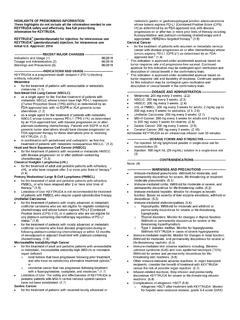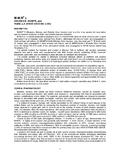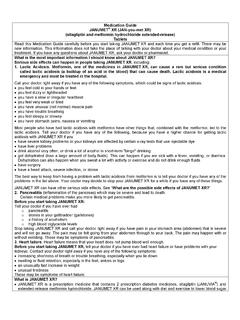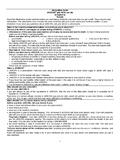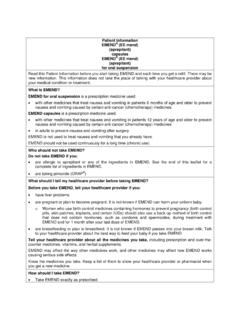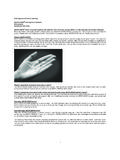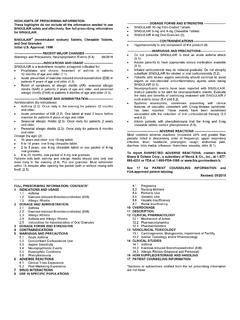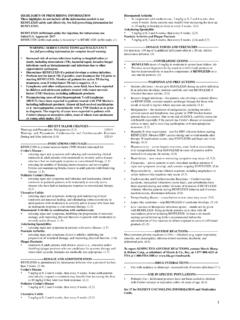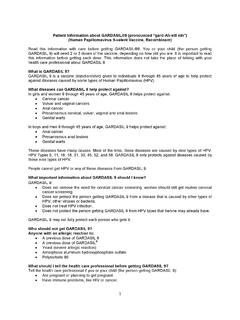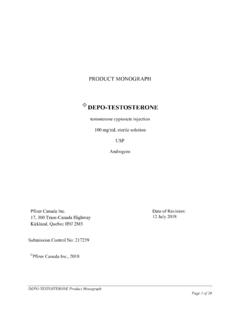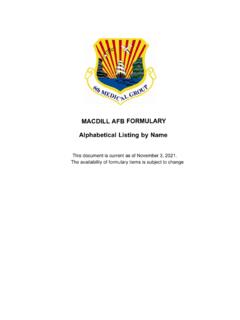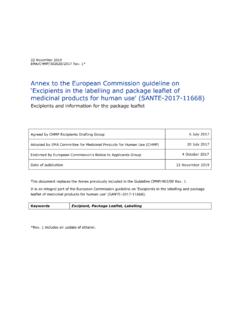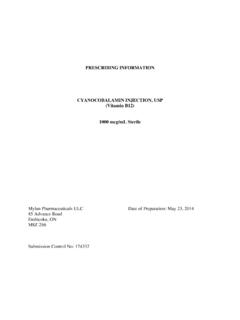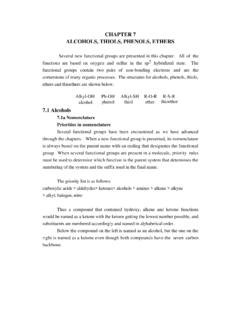Transcription of Pregnyl (chorionic gonadotropin for injection USP)
1 1 Pregnyl (chorionic gonadotropin for injection USP) DESCRIPTION Human chorionic gonadotropin (HCG), a polypeptide hormone produced by the human placenta, is composed of an alpha and a beta subunit. The alpha sub-unit is essentially identical to the alpha subunits of the human pituitary gonadotropins, luteinizing hormone (LH) and follicle-stimulating hormone (FSH), as well as to the alpha subunit of human thyroid-stimulating hormone (TSH). The beta subunits of these hormones differ in amino acid sequence.
2 Pregnyl (chorionic gonadotropin for injection USP) is a highly purified pyrogen-free preparation obtained from the urine of pregnant females. It is standardized by a biological assay procedure. It is available for intramuscular injection in multiple dose vials containing 10,000 USP units of sterile dried powder with 5 mg monobasic sodium phosphate and mg dibasic sodium phosphate. If required, pH is adjusted with sodium hydroxide and/or phosphoric acid. Each package also contains a 10-mL vial of solvent containing: water for injection with sodium chloride and benzyl ALCOHOL, WHICH IS NOT FOR USE IN NEWBORNS.
3 If required, pH is adjusted with sodium hydroxide and/or hydrochloric acid. CLINICAL PHARMACOLOGY The action of HCG is virtually identical to that of pituitary LH, although HCG appears to have a small degree of FSH activity as well. It stimulates production of gonadal steroid hormones by stimulating the interstitial cells (Leydig cells) of the testis to produce androgens and the corpus luteum of the ovary to produce progesterone. Androgen stimulation in the male leads to the development of secondary sex characteristics and may stimulate testicular descent when no anatomical impediment to descent is present.
4 This descent is usually reversible when HCG is discontinued. During the normal menstrual cycle, LH participates with FSH in the development and maturation of the normal ovarian follicle, and the mid-cycle LH surge triggers ovulation. HCG can substitute for LH in this function. During a normal pregnancy, HCG secreted by the placenta maintains the corpus luteum after LH secretion decreases, supporting continued secretion of estrogen and progesterone and preventing menstruation. HCG HAS NO KNOWN EFFECT ON FAT MOBILIZATION, APPETITE OR SENSE OF HUNGER, OR BODY FAT DISTRIBUTION.
5 INDICATIONS AND USAGE HCG HAS NOT BEEN DEMONSTRATED TO BE EFFECTIVE ADJUNCTIVE THERAPY IN THE TREATMENT OF OBESITY. THERE IS NO SUBSTANTIAL EVIDENCE THAT IT INCREASES WEIGHT LOSS BEYOND THAT RESULTING FROM CALORIC RESTRICTION, THAT IT CAUSES A MORE ATTRACTIVE OR NORMAL DISTRIBUTION OF FAT, OR THAT IT DECREASES THE HUNGER AND DISCOMFORT ASSOCIATED WITH CALORIE-RESTRICTED DIETS. 1. Prepubertal cryptorchidism not due to anatomical obstruction. In general, HCG is thought to induce testicular descent in situations when descent would have occurred at puberty.
6 HCG thus may help 2predict whether or not orchiopexy will be needed in the future. Although, in some cases, descent following HCG administration is permanent, in most cases, the response is temporary. Therapy is usually instituted in children between the ages of 4 and 9. 2. Selected cases of hypogonadotropic hypogonadism (hypogonadism secondary to a pituitary deficiency) in males. 3. Induction of ovulation and pregnancy in the anovulatory, infertile woman in whom the cause of anovulation is secondary and not due to primary ovarian failure, and who has been appropriately pretreated with human menotropins.
7 CONTRAINDICATIONS Precocious puberty, prostatic carcinoma or other androgen-dependent neoplasm, prior allergic reaction to HCG. WARNINGS HCG should be used in conjunction with human menopausal gonadotropins only by physicians experienced with infertility problems who are familiar with the criteria for patient selection, contraindications, warnings, precautions, and adverse reactions described in the package insert for menotropins. Anaphylaxis has been reported with urinary-derived HCG products.
8 The principal serious adverse reactions during this use are: (1) ovarian hyperstimulation, a syndrome of sudden ovarian enlargement, ascites with or without pain, and/or pleural effusion, (2) rupture of ovarian cysts with resultant hemoperitoneum, (3) multiple births, and (4) arterial thromboembolism. PRECAUTIONS General Since androgens may cause fluid retention, HCG should be used with caution in patients with cardiac or renal disease, epilepsy, migraine, or asthma. Pediatric Use Induction of androgen secretion by HCG may induce precocious puberty in pediatric patients treated for cryptorchidism.
9 Therapy should be discontinued if signs of precocious puberty occur. Geriatric Use Clinical studies of Pregnyl (chorionic gonadotropin for injection USP) did not include subjects aged 65 and over. ADVERSE REACTIONS Headache, irritability, restlessness, depression, fatigue, edema, precocious puberty, gynecomastia, pain at the site of injection . Hypersensitivity reactions, both localized and systemic in nature, have been reported. DOSAGE AND ADMINISTRATION 3 For intramuscular use only. The dosage regimen employed in any particular case will depend upon the indication for the use, the age and weight of the patient, and the physician s preference.
10 The following regimens have been advocated by various authorities: Prepubertal cryptorchidism not due to anatomical obstruction. Therapy is usually instituted in children between the ages of 4 and 9. 1. 4000 USP units 3 times weekly for 3 weeks. 2. 5000 USP units every second day for 4 injections. 3. 15 injections for 500 to 1000 USP units over a period of 6 weeks. 4. 500 USP units 3 times weekly for 4 to 6 weeks. If this course of treatment is not successful, another series is begun 1 month later, giving 1000 USP units per injection .
